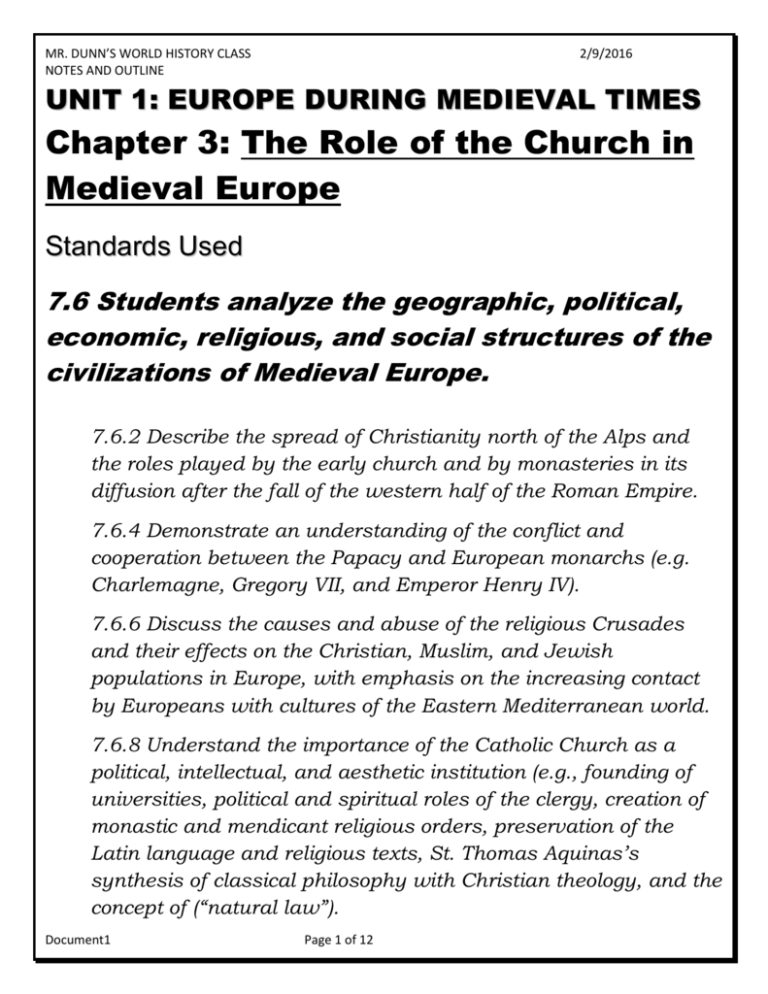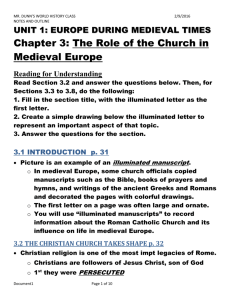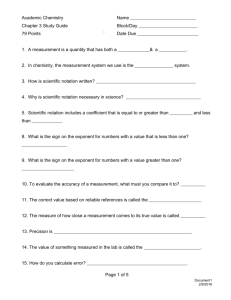What events did medieval holidays honor?
advertisement

MR. DUNN’S WORLD HISTORY CLASS NOTES AND OUTLINE 2/9/2016 UNIT 1: EUROPE DURING MEDIEVAL TIMES Chapter 3: The Role of the Church in Medieval Europe Standards Used 7.6 Students analyze the geographic, political, economic, religious, and social structures of the civilizations of Medieval Europe. 7.6.2 Describe the spread of Christianity north of the Alps and the roles played by the early church and by monasteries in its diffusion after the fall of the western half of the Roman Empire. 7.6.4 Demonstrate an understanding of the conflict and cooperation between the Papacy and European monarchs (e.g. Charlemagne, Gregory VII, and Emperor Henry IV). 7.6.6 Discuss the causes and abuse of the religious Crusades and their effects on the Christian, Muslim, and Jewish populations in Europe, with emphasis on the increasing contact by Europeans with cultures of the Eastern Mediterranean world. 7.6.8 Understand the importance of the Catholic Church as a political, intellectual, and aesthetic institution (e.g., founding of universities, political and spiritual roles of the clergy, creation of monastic and mendicant religious orders, preservation of the Latin language and religious texts, St. Thomas Aquinas’s synthesis of classical philosophy with Christian theology, and the concept of (“natural law”). Document1 Page 1 of 12 MR. DUNN’S WORLD HISTORY CLASS NOTES AND OUTLINE 2/9/2016 OBJECTIVES OF CH 3 • describe the structure and role of the Roman Catholic Church in medieval Europe and the influence of the church on art, architecture, and education. • summarize the conflict between Pope Gregory VII & Emperor Henry IV • compare and contrast the role of monks and friars in medieval society. • research and organize ideas for an illuminated poem that expresses your ideas clearly, demonstrating an understanding of grammar, structure, and the forms and genres of writing. Document1 Page 2 of 12 MR. DUNN’S WORLD HISTORY CLASS NOTES AND OUTLINE 2/9/2016 OVERVIEW OF CH 3 In this lesson, students learn about the Roman Catholic Church’s influence on life in medieval Europe. In a Writing for Understanding activity, they “visit” six medieval sites, such as the Chartres Cathedral in France and the University of Bologna in Italy, to learn about the church’s influence. Students then create “illuminated poems” describing what they have learned. Reading for Understanding Read Section 3.2 and answer the questions below. Then, for Sections 3.3 to 3.8, do the following: 1. Fill in the section title, with the illuminated letter as the first letter. 2. Create a simple drawing below the illuminated letter to represent an important aspect of that topic. 3. Answer the questions for the section. Document1 Page 3 of 12 MR. DUNN’S WORLD HISTORY CLASS NOTES AND OUTLINE 2/9/2016 3.1 INTRODUCTION p. 31 Picture is an example of an illuminated manuscript. o In medieval Europe, some church officials copied manuscripts such as the Bible, books of prayers and hymns, and writings of the ancient Greeks and Romans and decorated the pages with colorful drawings. o The first letter on a page was often large and ornate. o You will use “illuminated manuscripts” to record information about the Roman Catholic Church and its influence on life in medieval Europe. 3.2 THE CHRISTIAN CHURCH TAKES SHAPE p. 32 Christian religion is one of the most impt legacies of Rome. o Christians are followers of Jesus Christ, son of God o 1st they were PERSECUTED o In 313 emperor Constantine issued a decree allowing freedom of worship o In 395 it became official religion of Rome o Start of Middle Ages, all Christians were part of Roman Catholic Church Importance of church in early days: o One of few ties to more stable times o The Church provided leadership & even organized distribution of food o Monasteries, or communities of monks provided hospitality o Monks also copied and preserved old texts, helping to keep learning alive Document1 Page 4 of 12 MR. DUNN’S WORLD HISTORY CLASS NOTES AND OUTLINE 2/9/2016 3.2.1 the Organization of the Roman Catholic Church P. 32-33 Church organization was modeled on the structure of the old Roman Gov. By High Middle Ages there was a *system in which all clergy had a rank: 1. Pope – Bishop of Rome = supreme head of Roman Catholic Church 2. Cardinals – were his closest advisors 3. Archbishops – oversaw large or important areas = archdioceses 4. Bishops – governed = dioceses (cathedral) 5. Priest – head of parish with a church 3.2.2 The Increasing Power of the Church P. 33 The Church acquired great economic power: o By 1050 was the largest landowner o Monarchs gave some of the land o Some land was taken by force o They added to wealth by collecting a tithe = 1/10th of wealth, produce, or labor to help support church The Church also wielded great political power o Latin was official language of church o Was only common language in Europe o Since priests were only ones who could read they kept records + became advisors o Document1 Page 5 of 12 MR. DUNN’S WORLD HISTORY CLASS NOTES AND OUTLINE 2/9/2016 The Church’s power brought conflict with European Monarchs: o Between Pope Gregory VII + Henry IV (Holy Roman Emperor) o By 1073 priest could not marry o Outlawing the selling of church offices o Banned practice of Kings being able to appoint priests, bishops, and heads of monasteries o Henry wanted to still make appointments, Gregory said NO! o Henry was excommunicated o In the end Henry begged for forgiveness and gave the Pope the sole power to appoint Now you will get ready for the SIX STATION TOUR 3.2 The Christian Church Takes Shape How was the Roman Catholic Church organized during the Middle Ages? Each local parish was led by a priest. Parishes were groupie together into dioceses, which were led by bishops. Archbishops oversaw groups of dioceses called archdioceses. The pope, or bishop of Rome, was the leader over all. What role did the church play in government in medieval Europe? Church officials kept records and acted as advisors to monarchs. The church was the largest landholder and added to its power by collecting taxes. What was the subject of the conflict between Pope Gregory VII and the Holy Roman emperor, Henry IV? Gregory banned the practice of kings making appointments to church positions. Document1 Page 6 of 12 MR. DUNN’S WORLD HISTORY CLASS NOTES AND OUTLINE 2/9/2016 GUIDE TO READING NOTES CH 3 P16 Sec 3.3 Sacraments and Salvation During the Middle Ages, what was the purpose of sacraments, according to the teachings of the church? The church taught that Christians had to receive sacraments in order to achieve salvation. What seven sacraments were administered by the church? The seven sacraments were baptism, confirmation, Eucharist, matrimony, Holy orders, penance, and extreme unction. Document1 Page 7 of 12 MR. DUNN’S WORLD HISTORY CLASS NOTES AND OUTLINE 2/9/2016 GUIDE TO READING NOTES CH 3 P16 Sec 3.4 Pilgrimages and Crusades Why did people undertake pilgrimages during the Middle Ages? What were some of the popular destinations of pilgrims? People went on pilgrimages to show devotion to God, as an act of penance, or to find a cure for an illness. Popular destinations included Jerusalem, Rome, and Canterbury. What were the Crusades? The Crusades were military expeditions to the land where Jesus had lived. There purpose was to attempt to take back that land from Muslim control. Document1 Page 8 of 12 MR. DUNN’S WORLD HISTORY CLASS NOTES AND OUTLINE 2/9/2016 GUIDE TO READING NOTES CH 3 P17 Sec 3.5 Art and Architecture In what ways did the art of medieval Europe reflect the influence of the Roman Catholic Church? Since most people could not read, art helped them understand Biblical stories. What were cathedrals? What were some of their key architectural features? Cathedrals were large churches and the seat of a bishop. Some key features included the nave, transepts, flying buttresses, gargoyles, pillars, and stained glass windows. Document1 Page 9 of 12 MR. DUNN’S WORLD HISTORY CLASS NOTES AND OUTLINE 2/9/2016 GUIDE TO READING NOTES CH 3 P17 Sec 3.6 Education What role did the Roman Catholic Church play in education during the Middle Ages? Most schooling took place in monasteries, convents, and cathedrals. Much time was spent memorizing prayers and passages from the Bible in Latin. Who was Thomas Aquinas? What did he try to do with theology and ancient philosophy? Aquinas was an Italian scholar of philosophy and theology. He tried to bring together ancient philosophical ideas about reason and medieval theological beliefs about faith. Document1 Page 10 of 12 MR. DUNN’S WORLD HISTORY CLASS NOTES AND OUTLINE 2/9/2016 GUIDE TO READING NOTES CH 3 P18 Sec 3.7 Holidays What events did medieval holidays honor? Medieval holidays honored important events in the life of Jesus, such as his birth and Resurrection. Holidays also honored Christian saints and important religious concepts. What were some of the ways in which people celebrated holidays? People celebrated holidays by attending church and with feasts, music, dancing, games, and other forms of entertainment. Document1 Page 11 of 12 MR. DUNN’S WORLD HISTORY CLASS NOTES AND OUTLINE 2/9/2016 GUIDE TO READING NOTES CH 3 P18 Sec 3.8 Monks, Nuns, and Mendicants What was the monastic life like? Monks and nuns took vows of poverty, chastity, and obedience. They spent their lives in work, study, and prayer, living in separate communities called monasteries and convents. How were the lives of mendicant friars different from monks? Friars did not shut themselves off from the rest of the world. They traveled among ordinary people to preach. Document1 Page 12 of 12









